 |
  |
 |
  |
Chidaakaasham: Myriad Expressions of Art (Day 1) - A.M. Hari Shankar e-mail: hshankar252@gmail.com February 10, 2021 Last year had been a tough time for the entire mankind, especially, when it comes to the fraternity of artists and art lovers, it was annus horribilis. But nothing could stop the art enthusiasts and practitioners from getting themselves involved during this challenging time with some contribution to the field of their expertise. To everyone's surprise, there evolved a new idea of conducting online festivals and webinars. Even though the performing artists would not be able to do a complete justice to their presentations, leaving both the performers and the connoisseurs dissatisfied due to the unavoidable technical constraints at both the ends, webinars turned out to be a well-accepted and well-participated cultural affair. In 2018, a remarkable national seminar on Mohiniattam titled 'Kaisiki Vritti', after 60 glorious years of the All India Dance Seminar (1958), where Mohiniattam had its first time national level exposure was organized by Trikalaa Gurukulam, a pioneer organization in Delhi under the aegis of Sangeet Natak Akademi, Delhi. This time, Trikalaa Gurukulam in collaboration with Aatmalaya Academy, Bangalore, organized Chidaakaasham, a two-day International Webinar (Dec 26 & 27, 2020) featuring eminent artistes, scholars, academicians from Indian universities, institutions abroad who enlightened the audience with their talks and performances on a wide array of topics that focused on rare metric patterns, rhythmic combinations in various genres of music and dance, both classical and folk, pan Indian, western music, Indian philosophy and rituals. Inaugural address by veteran Dr. Sonal Mansingh highlighted the different dimensions of the title 'Chidaakaasham' and its connection with the cosmic energy profoundly where she added Chidaakaasham as the deepest point of consciousness. Aakasha, the space ever expanding and ever present is in the confines of body and mind, where the cosmic play happens. The jewel of inner consciousness resides in our hearts to receive the enlightenment. Eternal rhythms of 84 lakh bhavo-bhava/yonis in different births and the manifestation of rhythm in life, our breath-inhalation and exhalation of the praana ideally is in chaturasra gati and there is Tisra, Mishra, Khanda, Sankeerna gatis also in our life if we keenly observe. Relating daily life activities to maatrakaalam, and maatrakaalam to the kaala chakra / cosmic cycle, which is reflected in rithu chakra / season cycle, for musicians and dancers as taala chakra / rhythm cycles, the mano chakra / bhava chakra / kalpana chakra / shareera chakra / manodharma chakra in different situations all emanating from the basic principle of naada, the subtlest vibrations in space. This felicitous talk by Dr. Sonal Mansingh was befitting for commencing of the webinar. Prof. Choodamani Nandagopal: Taalapramana in Sculpture and Rhythm, the live beat of Indian Arts 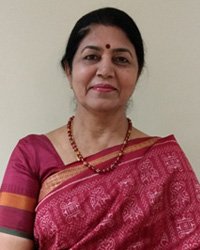 Prof. Choodamani Nandagopal An internationally acclaimed art historian, Dr. Choodamani started her session with going to the deepest meaning of a water droplet falling on to a pond which happened to be the backdrop of her presentation. As per her view, Indian art cannot be segregated from one another, but it is an integrated field as mentioned in the Vishnudharmottara Purana. Taalamana in sculpture and architecture is a traditional system of Indian Iconometry based on Shilpa Shastras that accounts for the measurements and proportions in temple and related architectural marvels, the influence of which seems to be reverberating in performing visual art forms also. Rhythm in nature (prakriti) can be manifested as laya in raindrops, flow of river, waterfalls, waves, breeze where we can experience subtle vibrations. Only an aesthetically sensible individual can appreciate it even though it's not art in itself. But this inspires artists to create something (kriya) new by which eternal action and reaction happens in a continuous process forming kala taranga or kaala taranga with different levels of experience while creating. Prana and laya are interdependent on each other for survival, added the Tagore Senior National Fellow. Harmony, Balance, and Rhythm is involved in every activity we perform, particularly inherent in artistic creations - music, dance, sculpture, architecture. Laya is the fleeting beat and taala is cyclic formation of continuity of laya even in sculpture using chisel and hammer. For completion they use taalapramana, rhythm associated with taala, laya, gati, taranga, kaala, maatra, laghu, druta. In Sanskrit, taala (tul) means bottom at the base (foundation), which forms the base for music and dance and taalamana for sculpture and architecture. 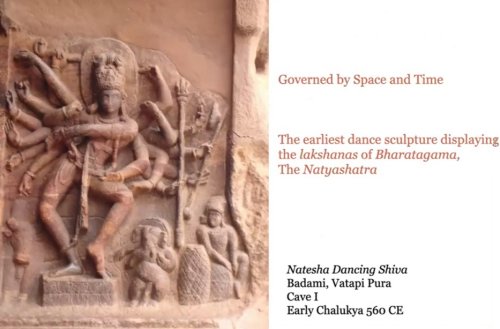 Natesha, the dancing Shiva of Badami, Vatapi Pura Cave I, made in the early Chalukya period 560 CE is the earliest dance sculpture displaying the lakshanaas of Bharataagama (one of the Aagama texts- the collection of Tantric literature and scriptures of Hinduism). Here, in the picture, one can see the hastas with many armaments. The taala is kept in this work. The movement of Natesha himself in kuttithapaada indicates that he has just completed the unit or particular counting unit and coming to that particular posture. The drummer (taala vadaka) has just banged it, meaning the taala is coordinated. 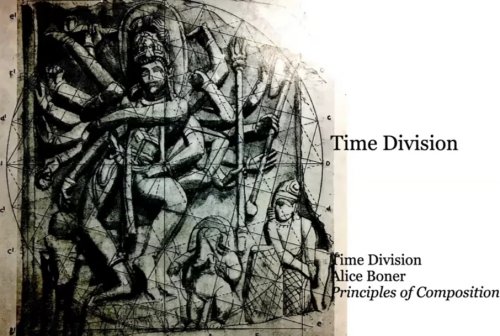 Alice Boner, an art historian in her research of principles of compositions in Indian Art, studied the time and space division in architecture. Every aspect of the taalapramana coordinates in the Bindu, the central point. Time division taalamana, the cross movements of every limb, organ is placed in that particular taalapramana. The Kanchipuram Kailasanatha Temple of Pallava period 732 CE, showcases Shiva as a singer with musicians around west facing wall fašade. In the Nataraja from Chola period 1012 CE, taking base line as taala with vertical and horizontal line meeting at a point from where measurements are taken and Shivakaami portrayed as small, as it would conflict with the flames of Nataraja. 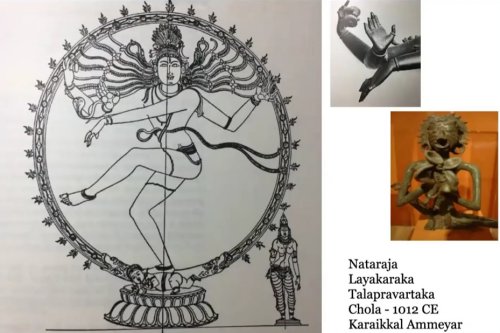 Karaikkal Ammeyar, a dissipated sculpture in which a beautiful lady plays cymbals for Shiva to dance, and she, mesmerized by watching his magnificent dance, continues it for ages without knowing when she became old, dissipated, immortalizing layakaraka and taalapravartaka. Aagama texts are important in giving the taalapramana and the complete structure of how to take the measurement of every structure. Taking face as one measurement, we can see Dasa or Nava taalapramana (10 or 9 measurements respectively) sculptures. It is believed that Vishwakarma, the earliest deity mentioned in Rigveda, created the taalapramana for sculpture and architecture. 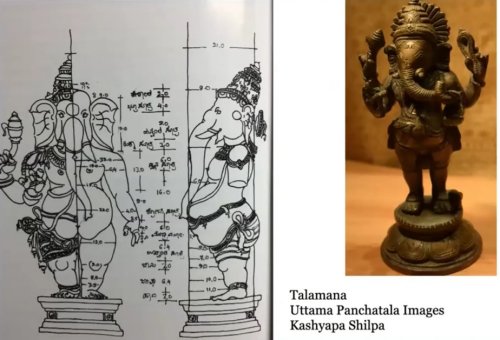  Sculpting initiated from the boulder stones will be checked by the sthapathi, the main sculptor. Three types of stones are mentioned in texts - Masculine stones giving metallic sound like tin, tin on hitting, will be kept in garbhagriha for carving the main deity, feminine stones giving tak, tak sound, neutral stones giving dak, dak sounds. Boulders become dressed stones and will be carved for icons. Sculptors work on this using just hammer and chisel only creating marvels on stone. Uttama Dasataala and Uttama Navataala sculptures for main Devata and Devi icons and Uttama Panchataala for Ganapathi or Karthikeya icons, according to Kashyapa Shilpa Shastra, now also in use by sculptors. In the 7th chapter of Brihath Samhita and Manasolassa text by Someshwar Chakravarthi, there is a lengthiest chapter on sculpture giving details of how to take measurements, even the minutest detailing from one edge of eye to another eye of the icons which is usually found in standing, seated or reclining position. 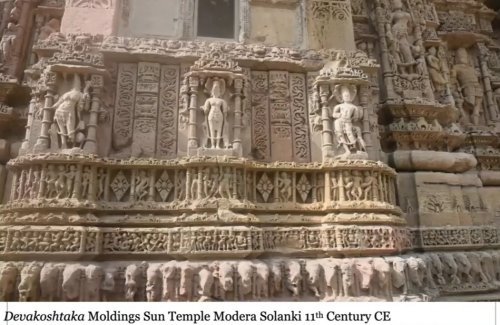 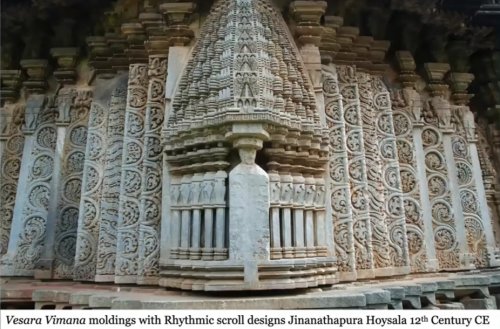 Rhythmic movement in architecture can be seen in Vimana mouldings in Bhoga Nandishwara temple, Nolamba. The entire shikhara from bottom to top is in rhythmic progression in architecture. Devakoshtaka moldings in Modhera Sun Temple,Solanki, 11th century CE and Vesara vimana mouldings with rhythmic scroll designs in Jinanathapura Hoysala temple, 12th century CE, repetitive scrolls is nothing but giving a kind of rhythmic vibrations in architecture. Taalataranga pillars in Vithala temple, Hampi, made in Vijayanagara 16th CE produce different sounds when they are hit, giving a feeling as if the drummer at the entrance of the Kalyana mandapa is making the sounds, the coordination of the arms of the drummer in this work as well as the rhythmic dance movements integrated with rhythmic designs in Pindi bandha in a pillar at Ramappa temple. Telangana marks a wondrous example of taalataranga or taalapramana in architecture. 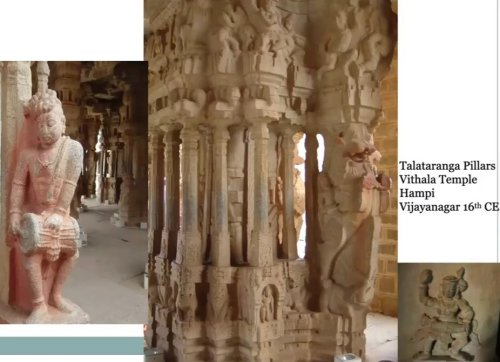 Dr. David Claman and Dr. John McDonald: Stolen Time -The Concept and Practice of Rubato in European Classical Music 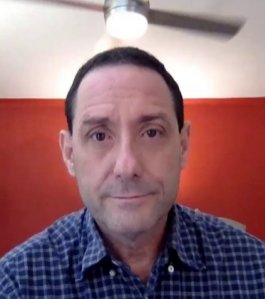 Dr. David Claman  Dr. John McDonald  Frederic Chopin, one of the top rank European composers, has composed many compositions for solo piano with the incorporation of Rubato. They explained the concept of Rubato with Mazurka, a polish dance song, using a three beat meter (Rupakam in Carnatic music) with a particular rhythmic emphasis which was later modified to become an instrumental composition. The composition itself is separated into three sections ľA section in A minor (Asaveri / Natabhairavi), B section (Bilaval / Shankarabharanam) and again A section in A minor (Asaveri / Natabhairavi). This new concept was very well received by the attendees and scholars alike which provided a new insight of Rubato in European classical music. Dr. RS Nandakumar: Maatrakala (Meter, Prosody and Periodization) in Prabandha 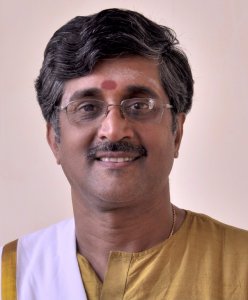 Dr. RS Nandakumar The prolonged explanatory discourse by Dr. Nandakumar stood unique among other presentations for the novelty of the topic and also his deep understanding and assimilation of the maatra and chandas concepts. Maatra and kaala becomes the basis of Indian music where the taalas can be ritualistic like the vedic chandas and loukika chandas. Sama recitation bring maatrakaala in music as a new concept. 'Kaalavakasha bhoomikaayaam tatvanusandhanusoudhasanghaanam' meaning if you are given a time frame, that will become the playground to create and intellectualize and that in itself becomes music over time. The kaala is so embedded in us and we the artists also do its anusandhaana. There is a sloka in Indravajravritha, a loukika chanda, "Kaalavakaashahithabhumikasu satvam sadadheemahi sartha tatvam", which can be sung in prati taala of ancient desadi taalas. Lexical meaning for maatra is said to be the single most unit to determine the time of the taala. It's a quantity of measurement of time. The time in deshadi, suladi taalas are laghupramaana taalas as laghu is the taalaanga. Maatra is a laghu taalaanga pramana. It's the half measure of time taken by a Panchami bird to utter a swara as mentioned in the Kohalamatham, a tantric text combining tantra and music, giving the working of sangeetha-nritta deeksha. If you can create laghu in a particular pattern or group together, it becomes a Varnam and the time taken to utter five such Laghu Varnams is known as maatrakarana. The 13th century musicologist and author of Sangeetha Ratnaakara - the classical Sanskrit text on music and drama - Sharangadeva gives kaala and kala as 2 distinctive features. For taala, "Nanamargeyihi layoyetrayathinaam syathkalanidhou tam daakshinam shivam naumi chitham vrithi mayam druvam, taalaha taalaprathishtaayaam ithi dhatorghaysmithaam". Taala is taalaprathishtitha, which could be paada prshta and hasta prshta. When you bring down the palm or foot on ground, it becomes taalaprathishtaayam. "Geetham vadyam thatha nrithyam yatha taale prathishtitham", the music and dance occupies the taala and taala will take time. In Umapadam text, samagana chandhas are incorporated in music. The vakprapancha evolved many loukika chandas for Shastranirmana. By putting all these, the Indian system of taala is categorized in an orderly manner and segmented and gave us taalashadangaas (6). Umapathi says in raga Saraswathi, "Bhoothopathim pravishyaami......naadopathyaakaaranam". The Universe happened by naada. The concept of viraama kala akshara pramana can give future perspective research of Rubato in Indian music as well. Avadhaana, to speed up and give emotive expressions to the listeners. Anubhava (experience) to anusandhana (self-involved assimilation) to rasa (essence) rather than ishta (likes) and anishta (dislikes) in music. In viramakala, even maatra continues with chandas based in chandoviraama. Kalapramana is the pramana between two ghataas, the time taken in-between the 2 beats in kaalaopramana. Sharangadeva says if we have kaala, kala is the silence. Magnificent description of kaala can be seen in the Sangeethasastra. Kala is the silence, just like the aahatha (naada with striking) and anahata (naada that continues even without striking). Vedic chandas gives rise to lot of ritualistic experiences, giving rise to taalapramana as said in Naradeeyashiksha text. In Charanavyooha text, it is said that Vedic chandas are "Chandapaadothovedasyahasthoukalpaha athapadttathe, chakshuhu niruktham shrothamuchyathe, shikshaangranathu vedasya mukham vyakarama smrutham", It gives the entire picture of what and how chandas reflects the vedas where the paadas with which Vedas moves in recitation, vedarig becomes vedamantra by anusandhanam. Naradeeyashiksha also gives maatralakshana, comprehensive meaning of maatra and kala wherein it can be used for its performance, practice and teaching also -"Trishrovruthyobhavanthi ghrtha, madya vilambita eti druthaayam vruthou trikalamaatra bavathi slokam. Chathuskala madyamaayam..." (performance and practice), Panchakala vilambithaayaam (teaching, extended rhythm), abhyasaarthe drutha vrithim (Doing in trikaala) and prayaagarthethu madyama (like rubato) can go to tisra speed up and panchakala (slow) and coming back to madhyama. In Veda recitation, the laya rhythm is called vruthi and the entire musical phrase as vruthi and its constituent is maatra. In vedic chandas, kalamarga, kriya are the constituents. The nishabda is kala and time difference between two shashabda kriya is kaala and time cycle thus formed are further categorized into 10 praanaas (taalas and chandas). Raaga also has 10 pranas. In Chandokya Upanishad, the jeeva bestowed by cosmic entity created praana which comes from the angusta in the garbha, and jeeva enters from the shira (top) and interacts with panchabhoota with panchendriyas-karmaendriyas and njanendriyaas. India music has taken both loukika and vedic chandas. Out of the 128 desi taalas, the simhanandana taala is used in Kuchipudi to create simha (an image of lion) while they dance, creating simhanandini. Prathimanda taala, the early adi taala using loukika chandas and many of its constituents gave rise to prabhandas. 'Muhuna praasa' used by royal composer Swati Tirunal, and Ela prabhandas encompasses all these. In Lakshmipraaturbhaava udantadanka in panchamaatra gana, where the provisions of kala and kaala are used on the basis of the maatra these concepts were very well demonstrated with his soulful singing. Dr. Rajashree Warrier: Emotions in Rhythm 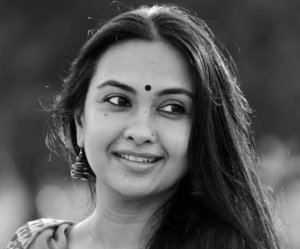 Dr. Rajashree Warrier A much celebrated artiste with innumerous roles in the field of art, known for her distinctive style of Bharatanatyam dancing, she shared her experiences with layam as a singer, dancer. theatre artiste and an occasional writer. Her question of whether the heard or unheard /uttered or unuttered carry any emotion in its silent interiors, how the time felt, is it the mode of reckoning, adhering to the basic method of taala counting to make it visible of its angas or other components... created a very inspiring plot, drawing the keen attention of her listeners. These angas bring space to merge as visible, thus brightening the space otherwise invisible, to throw light on the deep dark, layered shades of emotions. Time reckoned is also the space felt by the senses, like an idea which takes its time of momentary creative urge like a seed to germinate, like an idea taking time to take the form of a word. Time, in its curves and straight, manifests into two or more entities showing space and its intended emotions. While the emotional range is defined by the nature of progression, it could be also in terms of its shapes like linear, non-linear, curvy; also it could be in terms of slow, medium, high speeds or increasing or decreasing volume. This is how time brings emotions to sound. With her experimental production, envisioning time as a metaphor to contain emotions and panchabhootas in the cycle of births and deaths, connecting the idea to the cohesion of elements in seed, its ideation and thought of its own possibilities in the process of germination of its journey as a Vatavriksha (a full grown tree), Panchajaati alarippu in eka taalam was used to represent the process of birth and germination. She wanted the time to be felt in tisra, misra, sankeerna in the vilamba kaalam for going to its root emotions to convey rather than the normal appropriate nature of nadais in taalas. Eka taala was molded as a crest of the seed and jaathis as distinctive emotions. Generic representation of emotions with nadai like a normal Taka Takita Taka Takita may recall us of the majesty of veeram. With the same sound with varied emphasis, Taka Takita Taka Takita has an emphatic quality not like ta-takita di-takita taka takita ta-jam having assertive or veera rasa. The same in vilamba kaalam represents pulling a weight long way or the movement of a mighty goddess. The tonality, volume, swing could represent a gender depending on how we articulate through its space, volume, emphasis, tone. In varied paces, the same chollus (syllables) giving different emotions. Even the korvai, with remarkable spaces or interval may give different emotions in the same korvai just like how the different modes of adjusting the background and object focused in a photograph, give eloquent qualities to the piece. Representation of cultures can also be correlated by the way of reckoning; Marma taala in Kerala taala paddathi is an example. This can be combined with chaapu taalas but the mode of reckoning is different and is reflection of the culture of that region internalized. In her production Bhagavathi chinthu, a chollu by Kalavam Narayana Panicker was incorporated in the scene of the goddess's ceremonial procession giving a rhythmic setup of Kerala and Tamil cultural convergence in temple songs and rituals with adavus in mallari style and movements that speak of the ethos of Dravidian procession but the taalam and chollus resounded mela paddathi of Kerala's traditional music system. Rajshree's Bhagavathi (Devi) was positioned in the border of Tamil Nadu and Kerala. In her Lankalakshmi production based on a drama penned by renowned playwright C N Sreekantan Nair portraying Ravana not in perspective of Rama or not as in Ramayana, she used gestures that are similar to the way she envisaged Ravana after reading the monologues and she internalized the words in a colloquial way and the actions portraying that in the colloquial way itself, the expressions manifested in her mind when she attempted this particular production giving a Keraleeya prakrutham / Keralite nature to Ravana. A Malayali Ravana recreated due to her internalization of the character as a Malayali even though she did nothing intentionally for this. The way we perceive or conceive a word is somewhat complementary to how it would be portrayed through our body gestures. Unfortunately, her thought provoking presentation had to discontinue midway due to some network issues. Satvik Venkatesh: Music and Artificial Intelligence 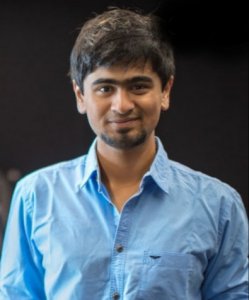 Satvik Venkatesh A young promising scholar joining from University of Plymouth, Satvik Venkatesh dealt with a very novel topic, Artificial Intelligence used in algorithm composing and sound processing for information retrieval. A musician would work to transfer his work to a knowledge engineer to play the machine like an original player. The way to be played, time gap given would be transformed to a set of rules and data but the knowledge bases would be biased as it is the recording of one single artiste only. Models of composition come from inspiration and innovation. In one of his projects, he worked in Biocomputing for musical composition. A plasmodial slime mould of Physarum polycephalum found in forests has been found to have intelligence properties. Suppose we sprinkle oat flakes around its surface, the organism actually finds the shortest or optimal path for the food source. Used as an electric component connected to an electrical circuit, it also has the ability to act as a memorister with lots of its own inherent memory. If we apply a series of voltages, it remembers to some extent what the series of volts were. Using this ability, it can compose new music sequence from input music electric volts. Input-music will be converted or translated to voltages - Physarum - sensing the current through the circuit which will be translated to music-output music. The organism would be composing its own composition on the basis of this. His composition 'Creep into lawn' was used for this. For sound processing, timber transfer is done by user input, neural network, digital signal processors for signal processing. Music information retrieval involves raaga recognition, beat tracking and automatic music transcription and audio segmentation. The topic was of greater importance, but being novel and less heard before, it appeared to be less understandable in such a short duration presentation and at the same time its scope is immense and yet to be recognized. The future of this concept pertaining to Indian music would be safe in the hands of Satvik. Saralaya Sisters: The Versatility of Varnam as a composition in Carnatic Music 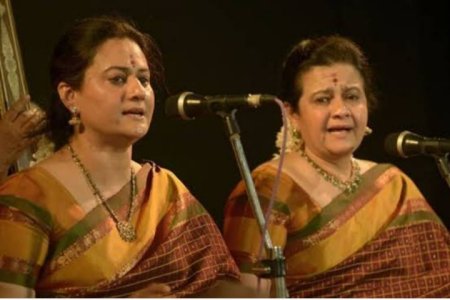 Saralaya Sisters Kavitha & Triveni Varnas are exemplary compositions akin to Carnatic music. There are numerous varnas composed by great scholars from centuries as well as varnas composed by contemporary composers in various ragas. They play a unique role in the abhyasa of classical Carnatic music and a pivotal role in Bharatanatyam margam as well. Varnas usually comprise a pallavi, anupallavi, charana (comprising of a line of sahitya followed by chittaswaras). Varna is presented as the first item and it aids in warming up due to its structure. Varnas lay a firm foundation for the learner with respect to understanding raga swarupa, taalam and laya control and manodharma sangeetha in the nerevel and swara prasthara passages. In Bharatanatyam also, varnam forms the main piece with the scope for both abhinaya in the sahitya and the intricate patterns in the nritta and laya passages. Varnas are broadly classified into Taana Varnas, Pada Varnas and Daru Varnas. Taana Varnas have sahitya only in the pallavi and anupallavi and only chittaswaras in the charanam. Pada varnas have sahitya incorporated in the anupallavi and the chittaswaras of the charana. Daru Varnams have in addition jatis put into the anupallavi section. Pada and Daru Varnams are common to both Carnatic music and Bharatanatyam recitals. On talking about the raga structure, in "Sarajinabha" in Kambodhi by Vadivelu, the essence of the raga is evident from the first line itself. It also helps to gain knowldedge of sahitya bhava in other compositions and nerevel in the same raga. In "Viribhoni" by Aadi Appaiyer in Bhairavi set in ata taalam, the beautiful picture of the raga is painted in the first stanza itself which could be the magnum opus for the rest of the sangathis of Bhairavi raga that will help in understanding the raga swarupa. It is also essential for the listeners to be able to identify the raga in the very first phrase of an alapana or composition. The Varnas bring out this aspect very clearly in the first line of the Pallavi itself and there is no ambiguity as to which raga it belongs to. Practicing varnas in Aakara in vilamba and madhyama kalam will give a kaleidoscope of the raga delineations. This practice will heighten the grip over laya and the splitting of the sahitya according to the underlying swara which will give an insight of how and where to use gamaka prayoga as well. Apart from the existing sangathis in Varna sahitya, there is ample scope for one to present the same with embellishments according to one's own manodharma and sahitya bhava curated through the practice of Varnas. Hence, it proves to be a great tool in the voice culture and modulation techniques that goes a long way in the aesthetics and phonetics of Carnatic music. Example in Sarasuda varnam by Kotha Vasil Venkataramana Iyer in Saveri set in adi taalam, the opening itself gives an insight to the beauty of Saveri. In the second line, "Chaala....", the gamaka prayoga of Saveri is clearly evident. This line resonates the essence of Saveri in touching the pivotal point of the raga. The beautiful usage of jaaru gamaka speaks volumes of Saveri in this particular varna. Coming to the abhyasa in terms of swara patterns and the rhythmic patterns interwoven into them, is the usage of Janti and Datu Varisais in composition in Sahana in adi taala by Thiruvotriyur Tyagaraja. Practicing these swara combinations in various kaalaas will give a firm grip over swarasthanams, laya and swara prastharas. The third chittaswaras in the charana section of the Varna usually comprise of swara patterns without any dheerga swaras like in Sahana, Hamsadhwani and Durbar varnas. Continuous practice and perfecting this in vilamba and madhyamakala will help immensely in breath control for vocalists and laya control for instrumentalists. The Saralaya sisters demonstrated all these points with compositions of ancient composers and contemporary composers like Lalgudi G Jayaraman, T R Subrahmaniam and Dr. M Balamuralikrishna which set a great example of the versatility of creative excellence that the compositional structure of varna has to offer in terms of raga, laya and its varied aesthetics. Apart from taking a bit more than the stipulated time for all these voluminous discussions, the sessions were highly informative and very well received fulfilling the aesthetic thirst of its audience. Chidaakaasham: Myriad Expressions of Art (Day 2) 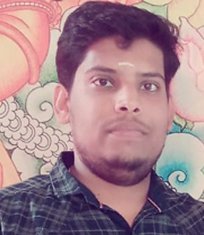 Delhi based A.M. Hari Shankar currently working as an Editor in a leading publishing company by profession, is a percussionist and an art enthusiast by passion. Comments * A very enlightening subject wherein the scholars have researched and brought it to the limelight. Thanks for giving such a precious information. - Dr. Mala Shashikanth, Director, Kaishiki Natyavahini (Feb 14, 2021) Post your comments Pl provide your name and email id along with your comment. All appropriate comments posted with name and email id in the blog will be featured in the site. |